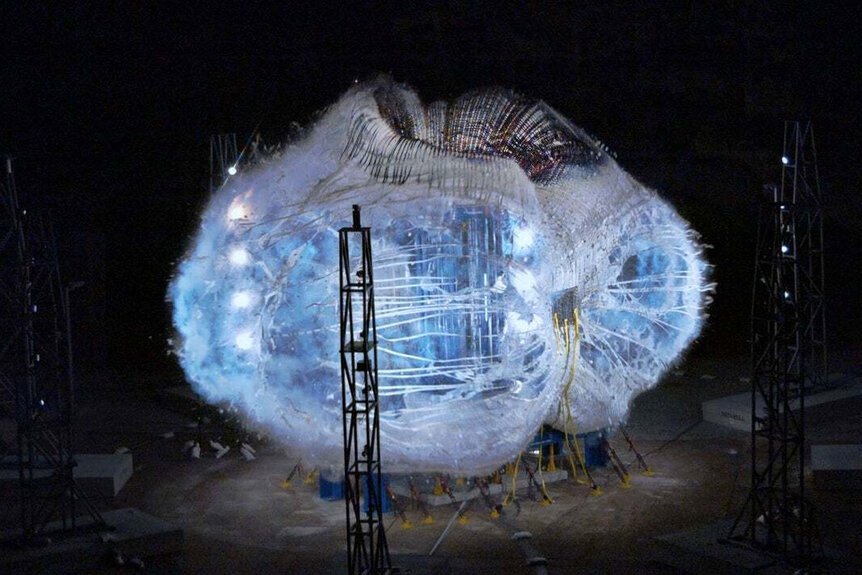Create a free profile to get unlimited access to exclusive videos, sweepstakes, and more!
Why Sierra Space Popped Its Inflatable Space Station Module on Purpose
Explosive decompression is more desirable on Earth than in space.
The crew of The Ark (streaming now on Peacock) have plenty to worry about. Even if things had gone according to plan, they still would have arrived on an alien planet with no existing infrastructure or support. But things didn’t go according to plan. Midway through their journey, something went wrong with the ship. What was left of the crew found themselves caught between stars, with no one to depend on but themselves.
In space, even as close as low-Earth orbit, the only thing standing between the crew and a swift death is the reliability of their habitat. Spaceships and space stations offer a small bubble of livable atmosphere in a nearly empty void, and keeping that bubble intact is priority number one. In an effort to prevent their experimental space station from popping a leak in orbit, Sierra Space recently exploded their habitat on purpose.
Sierra Space Breaks Their Space Station to Make Sure it Works
Sierra Space is a commercial company working on inflatable, expandable modules for future space stations. Inflatable stations are desirable because they can be launched in a compressed state and later expanded to their full volume in space. That means you can get larger objects into orbit on smaller launch vehicles. Sierra Space’s LIFE habitat, short for Large Integrated Flexible Environment, can launch on a typical 5-meter rocket and later expand to roughly 5 times its original volume.
RELATED: The Life and Death (in 2031) of the International Space Station
The trick with an expandable module is finding soft materials capable of expanding to the correct volume while still holding pressure and keeping its occupants alive. The LIFE habitat is made partially of Vectran straps, a material composed of liquid-crystal polymers. Vectran has a tensile strength similar to Kevlar and is commonly used to reinforce terrestrial materials like electrical cables and boat sails. It’s also commonly used for space applications, including in spacesuits and supporting structures for Mars rovers and other spacecraft. Vectran has the benefit of being flexible and expandable, while becoming rigid after inflation.
Sierra Space built a test habitat with an internal volume of 300 cubic meters, roughly one-third the volume of the International Space Station (ISS), and they needed to know just how much pressure it could withstand. It turns out one of the best ways to figure that out is to keep inflating it until it fails.
The company carried out its first full-scale structural test to make sure the LIFE habitat could hold working pressure without popping. During the Ultimate Burst Pressure (UBP) test, the company intentionally broke their module in spectacular fashion to find out precisely how strong it is, or was. The idea is to build something that only fails in conditions which are more extreme than it's ever likely to encounter. Put simply, they pumped the habitat full of air until it blew up.
In space, habitats are pressurized to 15.2 pounds per square inch (psi), slightly more than the earthly air pressure at sea level. NASA, however, is famous for redundancy and recommends that all crewed spacecraft be capable of handling four times that pressure, for a minimum of 60.8 psi. The UBP test was intended to determine if the LIFE habitat could meet that requirement, and it passed the test with flying shrapnel colors. The module didn’t pop until it reached an internal pressure of 77 psi. That’s 27% higher than the NASA recommendation and roughly 5 times the pressure it would actually experience in space.
RELATED: NASA Wants to Build a “Space Tug” to Safely Destroy the ISS
Sierra Space has plenty more tests to complete before the module will actually fly and the company has plans for an even larger habitat with 1,400 cubic meters of internal volume. That habitat would launch on a larger rocket and have a larger internal volume than the ISS, all inside a single bubble.
As NASA and international partners plan to retire the ISS at the end of 2030, the desire for alternative space stations will likely increase. Sierra Space isn’t the only name in the commercial space station game, but they are certainly making noise.
It’s always best when your spacecraft doesn’t fail mid-mission. Just ask the crew of The Ark, streaming now on Peacock.



































